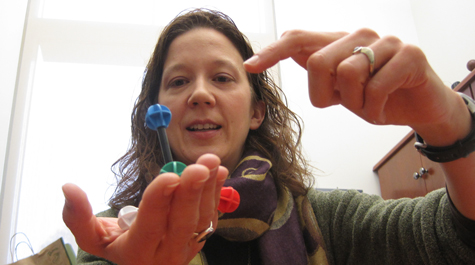AP story on chemistry mentor makes a big splash
Elizabeth Harbron’s inbox overfloweth.
Over William & Mary’s Homecoming weekend, the associate professor of chemistry received a flood of emails from all over.
“I got one from someone I graduated from high school with, and hadn’t heard from since,” she said. There were also congratulatory messages from former students, complete strangers and colleagues past and present. An email from Harbron’s faculty advisor from her days as an undergraduate at Grinnell College was especially appreciated: “He’s still an important mentor to me.”
Everyone was reacting to a national Associated Press story headlined “Women Making Slow, Sure Strides In Science, Math” by AP writer Martha Irvine. The story spotlights Harbron’s success in the development of young women scientists at William & Mary. Irvine used Harbron’s relationship with a former student, Rebecca Allred ’10, to help illustrate the gains women are making in degrees and careers in STEM fields—science, technology, engineering and math.
“That's a big deal in the STEM fields, which have been slower than other disciplines to integrate women at the highest levels,” Irving wrote.
Harbron says that William & Mary has been ahead of the national curve, maintaining an academic and research culture that’s conducive to the development of young, female scientists. For starters, she says, William & Mary undergrads get research opportunities that are snapped up by graduate students at many places.
“William & Mary has a strong emphasis on undergraduate research mentored directly by faculty—as opposed to undergraduate research mentored by a graduate student or a post-doc. Not every university can say that,” Harbron said. “When you come in to the chemistry department as an undergraduate you’re immediately higher in the hierarchy than you’re going to be in a larger program.”
She said that she’s seen that it’s particularly important for young women scientists to develop a sense of scientific confidence.
“With the kind of student you get entering William & Mary, the girls tend to be ahead of the boys at dotting their i’s and crossing their t’s and getting great test scores and completing applications,” Harbron said. “But it’s difficult to make that transition to situations where the answers are not known, like we have in a lab. Women seem to have a bit of a harder time getting over their fear of making a mistake.”
Harbron says it helps that William & Mary now has a number of women faculty in its science departments. “For some students, if they don’t see people like them represented in the faculty, it just becomes less appealing, I think,” she said. “We are reaching a critical mass of women scientists, but we still have a long way to go in creating a science faculty that looks more and more like our students.”
Megan Shearin, public relations and marketing specialist in William & Mary’s Office of University Relations, worked with Irvine over the summer to develop the story. The interview was scheduled on a day that turned out to be a few days following Hurricane Irene. Like many Williamsburg residents, Harbron had no electricity at home and several trees down on her property, yet gamely came into campus to go through with the interview. Associated Press photographers visited Williamsburg in the fall to photograph Harbron and some of her current students working in the Integrated Science Center.
The story appears on the web sites of national and regional newspapers from coast to coast, including The Boston Herald, The Minneapolis Star Tribune, The Denver Post, The Seattle Post-Intelligencer and The Anchorage Daily News. Dozens of smaller papers ran the story as well. A Google news search Monday morning generated 10 pages of links.
Irvine’s story also is making a big hit in new media. Scores, maybe hundreds, of Twitter users continue to tweet links to various incarnations of the story. It was picked up by Yahoo! News and Xfinity. Digital-only newspaper The Huffington Post also ran the story, spawning links throughout the blogosphere, including an admiring commentary on the story at The Mary Sue: A Guide to Girl Geek Culture. The Huffington Post article generated more than 2,000 comments. Skip to main content
Skip to main content

